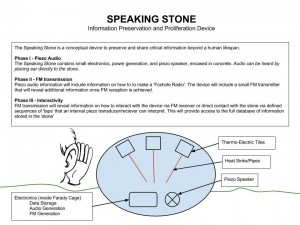This is an evolution of a concept I had for an ‘info-hydrant’ device that would preserve and proliferate information and knowledge in the event of catastrophic loss of technology, communication, and historical information about humanity and nature.
GOAL:
An inexpensive, accessible and easily replicated device that would serve as a repository of information. This device must outlast several human lifetimes, withstand elements and most casual attempts at theft and destruction. The device must be exceedingly simple to use, to the extent that a person with absolutely no knowledge of the device may be reasonably expected to discover it’s function.
PURPOSE/MOTIVATION:
There is a strong chance that some population of human beings will survive catastrophe. There is less chance that deep human knowledge about science, nature, and history will survive the same event. A speaking stone will provide the basis for rapid rebuilding of civilization in the event that communication and information are lost.
The motivation for this can be stated most succinctly in the words of Dian Fossey “When you realize the value of all life, you dwell less on what is past and concentrate more on the preservation of the future.”
CHALLENGES:
Language. This wholly relies on the idea that the language used in the device will be understood by the user. There is no guarantee for this. Essentially I’ve chosen to overlook this challenge and suggest the use of English and hoping that remains a dominant language form into the future. Alternative suggestions on this are welcomed.
Degradation/Theft/Vandalism. There is a possibility these devices will be destroyed by nature, theft, or vandalism. There is no fail-safe against this except by making these devices as physically difficult to destroy as possible, and by proliferating them as far and wide as possible. Another safety would be to encase the electronics in such a way that they cannot be accessed without destroying them. Additionally the value of the contents should be kept as low as possible to discourage attempts.
IMPLEMENTATION:
POWER: Thermo-Electric (Peltier) tiles placed just below the surface of the stone, with one side attached to heat sinks or pipes that run deeper into the core of the stone. The thermal gradient will allow a small array of these tiles to generate enough power (3-5W) to run the electronics.
ELECTRONICS: A Raspberry Pi or similar low power, single board computer could serve as a reliable and inexpensive controller and memory storage. A piezo transducer and possibly a small amplifier will be attached to the audio. In addition, the Raspberry Pi can be used as a simple FM transmitter with no more than a wire as an antennae.
SOFTWARE: Any OS could used, Debian would be fine. A text-to-speech synthesizer program should be installed. Storing information in text format and synthesizing audio will allow vastly more information to be stored than if audio formats were used. RISC OS is another option for the OS and may have more desirable characteristics.
INFORMATION STORED: This requires some thought and I don’t think any one person should decide what information is critical enough to preserve. I’ll leave this open for discussion. I would suggest storing mainly information on science and nature.
—
So that’s my spiel… This concept is clearly in the ‘alpha’ development stage and I’m open and eager for discussion and suggestion on all points. I hope I’ve presented this in a way that it makes sense, if not, open to suggestions on how to do that better too.

I had a thought for alternative use of this device, which wouldn’t have to wait for catastrophe, The spark for this came from an experience when I was chartering a sailboat in the Caribbean. One night we anchored at a remote island, and a lady swam out to us — well over a mile — carrying a trash bag, She was the schoolteacher and wanted to know if we had on board any books we had finished, She was desperate for any form of reading for her kids, We collected what we had, and she wrapped them up in the trash bag and swam back.,
Thinking of the speaking stone in this context, two ideas
1) for such remote schools, the SS could be a source of all sorts of global and technological knowledge that is unavailable or extremely hard to get by any other means., One per school as a teaching resource, or one per classroom as a learning tool — etc.,
2) There are a lot of small regions or communities in the the world that are not much more advanced than post catastrophe society. Their are methods of doing things that are within their grasp, but they don’t know enough to do them, or don’t understand why they are important. For example why and how to make water safe for drinking, make sanitary arrangements, use a bicycle as a driver to generate electricity or pump water, etc.
Either of these would benefit from visual as well as audible communication. If we postulate use in an environment of limited resources but in which people know what the stone is for and will value/protect it,a screen becomes more feasible than in the post-catastrophe conditions,
Don’t you think that if the world comes to an end that FM radio might be a bit advanced? Something that could be picked up with a “crystal” radio which can be made from very simple components rather than waiting for civilisation to reach a point where the rocks would be irrelevant because they’ve already reached the point where they can make FM radios.